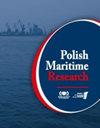Application of Fuel Cold Energy in CO2 Bog Reliquefaction System on Ammonia-Powered CO2 Carrier
IF 2
3区 工程技术
Q2 ENGINEERING, MARINE
引用次数: 0
Abstract
Abstract A CO 2 boiled off gas (CO 2 BOG) reliquefaction system using liquid ammonia cold energy is designed to solve the problems of fuel cold energy waste and the large power consumption of the compressor in the process of CO 2 BOG reliquefaction on an ammonia-powered CO 2 carrier. Aspen HYSYS is used to simulate the calculation, and it is found that the system has lower power consumption than the existing reliquefaction method. The temperature of the heat exchanger heater-1 heat flow outlet node (node C-4) is optimised, and it is found that, with the increase of the node C-4 temperature, the power consumption of the compressor gradually increases, and the liquefaction fraction of CO 2 BOG gradually decreases. Under 85% conditions, when the ambient temperature is 0°C and the temperature of node C-4 is -9°C, the liquid fraction of CO 2 BOG reaches the maximum, which is 74.46%, and the power of Compressor-1 is the minimum, which is 40.90 kW. According to this, the optimum temperature of node C-4 under various working conditions is determined. The exergy efficiency model is established, in an 85% ship working condition with the ambient temperature of 40°C, and the exergy efficiency of the system is the maximum, reaching 59.58%. Therefore, the CO 2 BOG reliquefaction system proposed in this study could realise effective utilisation of liquid ammonia cold energy.燃料冷能在氨动力CO2载体CO2沼泽再液化系统中的应用
摘要针对氨动力CO 2载体上CO 2煮沸脱气(co2 BOG)再气化过程中存在燃料冷能浪费和压缩机功耗大的问题,设计了一种利用液氨冷能的CO 2 BOG再气化系统。利用Aspen HYSYS进行仿真计算,发现该系统比现有的再液化方法具有更低的功耗。对换热器加热器-1热流出口节点(节点C-4)的温度进行优化,发现随着节点C-4温度的升高,压缩机的功耗逐渐增大,CO 2 BOG的液化分数逐渐降低。在85%工况下,当环境温度为0℃,节点C-4温度为-9℃时,co2 BOG的液体馏分最大,为74.46%,压缩机-1功率最小,为40.90 kW。据此确定了C-4节点在各种工况下的最佳温度。建立了火用效率模型,在船舶工作条件为85%,环境温度为40℃时,系统的火用效率最高,达到59.58%。因此,本研究提出的co2 BOG再液化系统可以实现对液氨冷能的有效利用。
本文章由计算机程序翻译,如有差异,请以英文原文为准。
求助全文
约1分钟内获得全文
求助全文
来源期刊

Polish Maritime Research
工程技术-工程:海洋
CiteScore
3.70
自引率
45.00%
发文量
20
审稿时长
>12 weeks
期刊介绍:
The scope of the journal covers selected issues related to all phases of product lifecycle and corresponding technologies for offshore floating and fixed structures and their components.
All researchers are invited to submit their original papers for peer review and publications related to methods of the design; production and manufacturing; maintenance and operational processes of such technical items as:
all types of vessels and their equipment,
fixed and floating offshore units and their components,
autonomous underwater vehicle (AUV) and remotely operated vehicle (ROV).
We welcome submissions from these fields in the following technical topics:
ship hydrodynamics: buoyancy and stability; ship resistance and propulsion, etc.,
structural integrity of ship and offshore unit structures: materials; welding; fatigue and fracture, etc.,
marine equipment: ship and offshore unit power plants: overboarding equipment; etc.
 求助内容:
求助内容: 应助结果提醒方式:
应助结果提醒方式:


